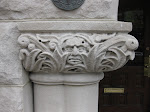Congratulations to Baltimore Heritage on 50 years of preserving Baltimore's architectural treasures!!!
See you at the Gala!
http://www.baltimoreheritage.org/programs/50th-anniversary/
Friday, June 11, 2010
Tuesday, June 1, 2010
Tool of the Week: Lasers!!
Here is a link to a week old article about using 3D imaging for documenting historic sites:
http://cosmiclog.msnbc.msn.com/_news/2010/05/25/4356809-monuments-immortalized-virtually
I can see a lot of uses for this technology in our field. Documentation is obvious, but the technology is also being used for part replication. Using 3D CNC routers any part can be duplicated from a 3D model. This would certainly help cut down costs for manufacturing by hand. Perhaps that is somewhat blasphemous, but the reality of budgets makes this type of process relevant. The number of hours to replicate several hand-carved Corinthian capitals maybe out of the reach of many property owners. Not to mention the ethics involved in reproducing something so exactly that the difference can't be told between old and new. A new plastic part replicated by a CNC machine would certainly be recognizable as non-original. The original wooden pieces could be preserved and stored safely for future generations.
The other possible use is virtual tourism. How about accessing a space that normally would be off limits like garret or attic spaces. Or perhaps recreating a site that is long vanished and would be impossible to replicate in the real world. Imagine walking the streets of ancient Rome or Dutch New Amsterdam.
I am a big fan of embracing the technology. The craft and the history have to be preserved, but progress and technological advancement should be embraced.
http://cosmiclog.msnbc.msn.com/_news/2010/05/25/4356809-monuments-immortalized-virtually
I can see a lot of uses for this technology in our field. Documentation is obvious, but the technology is also being used for part replication. Using 3D CNC routers any part can be duplicated from a 3D model. This would certainly help cut down costs for manufacturing by hand. Perhaps that is somewhat blasphemous, but the reality of budgets makes this type of process relevant. The number of hours to replicate several hand-carved Corinthian capitals maybe out of the reach of many property owners. Not to mention the ethics involved in reproducing something so exactly that the difference can't be told between old and new. A new plastic part replicated by a CNC machine would certainly be recognizable as non-original. The original wooden pieces could be preserved and stored safely for future generations.
The other possible use is virtual tourism. How about accessing a space that normally would be off limits like garret or attic spaces. Or perhaps recreating a site that is long vanished and would be impossible to replicate in the real world. Imagine walking the streets of ancient Rome or Dutch New Amsterdam.
I am a big fan of embracing the technology. The craft and the history have to be preserved, but progress and technological advancement should be embraced.
Subscribe to:
Posts (Atom)



